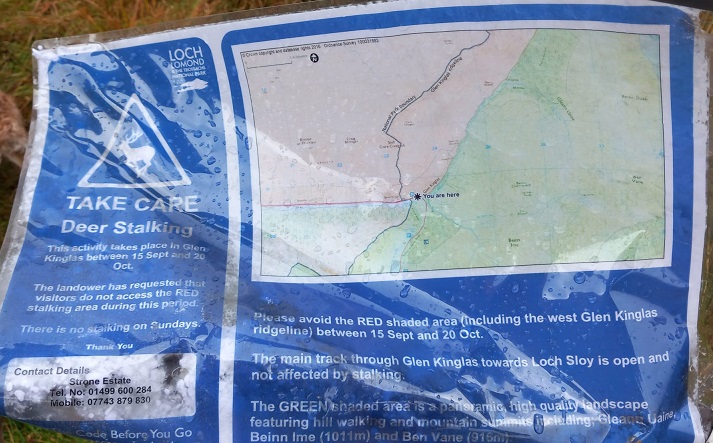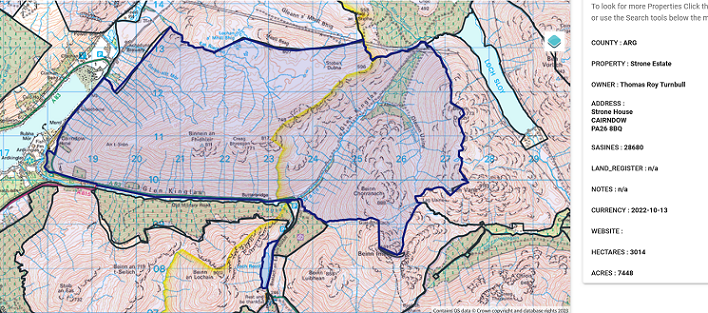
After the Land Reform (Scotland) Act 2003 was passed the days of sporting estate landowners trying to impose blanket restrictions on access across swathes of the countryside in the name of deer stalking should have ended. Unfortunately this sign shows that that practice, now unlawful, continues 20 years on. The red and green colours say it all, red for stop and green for go.
What makes this sign particularly outrageous is the landowner concerned is Tom Turnbull, chair of the Association of Deer Management Groups, and that it includes the logo of the Loch Lomond and Trossachs National Park Authority (LLTNPA) who, as an access authority, have a statutory duty to uphold access rights. (For a previous post about Mr Turnbull’s management of Strone, which covers landslips in Glen Kinglas, failed native woodland plantations, his views on deer numbers and a “conservation” initiative with the LLTNPA see here).

Clause 3 of the Land Reform (Scotland) Act created a legal duty to manage the land responsibly in respect of access rightsand more specifically not “to cause unreasonable interference with the access rights of any person exercising or seeking to exercise their access rights”. The Scottish Outdoor Access Code described further what that meant in respect to deer stalking:

What is absolutely clear from this is that blanket access restrictions, such that between 15th September and 20th October for the land coloured red in the map, contravene access rights. Landowners are specifically advised to tell people where stalking is taking place on a day to day basis and provide advice on alternative routes to popular destinations.
It is interesting therefore that the Strone Estate features under the southern highlands section of the Heading for the Scottish Hills website (HfSHs) (see here) which was last updated in August 2024:

It is even more interesting that this contains different information to that provided on the map – no hint of access restrictions here. Perhaps the Strone Estate realised NatureScot, who administer the HfSHs, would never have accepted such an attempt to restrict access? Assuming Strone, however, tells anyone contacts them through HfSHs to keep away from 15th September to 20th October it will help bring that service into disrepute.
The most likely destination of walkers heading onto the ground on the west side of Upper Glen Kinglass (ie that marked red on the map) is Binnein an Fhidhleir and the most popular route is straight up the steep slopes from Butterbridge by what has now become a path (see here). Other sporting estates have learned it is not difficult to arrange stalking around such routes and many now explicitly state they can be used throughout the stalking season. So why hasn’t Strone also taken this approach?
The likely explanation has nothing to do with the practicalities of stalking, whether on the steep slopes of Glen Kinglas or the more gentle slopes to the north. Mr Turnbull, who is unusual as a landowner in conducting most of the stalking himself, clearly shoots hinds without any need to ask the public to keep away. He could do the same for stags but stag shooting is far more exclusive and part of the social cachet for paying clients comes from being able to buy an exclusive experience where there is no-one else on the hill.
It may be that Mr Turnbull has used the LLTNPA logo without their permission. The weasle words on the sign, however, suggest they are involved: “The landowner has requested visitors do not access the red stalking area” attempts to avoid responsibility for what is described as a “request”. Actually, it is the LLTNPA’s legal duty to uphold access rights and firmly say no to unreasonsable “requests” like this. The claim that the green shaded area “is a panoramic – [whatever that means!] – high quality landscape” is merely an attempt to deflect from the substantive issue which is that attempts to ban access from one hill are not made more acceptable by saying people can go up another.
While the sign is now down and the period it covered over, I will be asking both NatureScot and the LLTNPA to address the issues described in this post.

Utter contempt for The Act! If any idiotic keeper suggests that you may get accidently shot then take the guns off them.
In response to JJ … hazard a guess that the pronicple reason these large estates ask walkers to stay out of areas that are set to be “stalked” has little to do with risks the walkers might be exposed to gunfire. Professional Ghillies who are trained in ‘fire control’ generally oversee the ‘guns’ involved. When random groups of people move across the glens in which deer are grazing this will displace those deer. Casual walkers leave scent trails and create noise which will cause herds to flee from sheltered hollows and tree lines into other places. This breaks up groups of deer, excites them and makes it far harder to select the weakest animals among the groups or spot relationships betwen calves and does. Herds are easier to cull if encountered in small groups relatively undisturbed.
Anyone who has ever stalked red deer on open hill would know this, even if they did not approve of advisory “keep out” notices outlining affected areas. (Or know much about deer stalking as a land management issue, for that matter ! )
Although as the article states, all these ‘problems’ you outline seem to be unproblematic once into the hind season, suggesting stalking practicalities maybe aren’t the key issue here.
I think there’s an issue here with your English comprehension. That sign doesn’t state that the area is closed; it asks walkers to avoid the area.
It’s not a “blanket restriction”. Describing it as such is a stretch
If you saw that sign on a walk you’d ignore it and exercise your rights of access, and well you know it
Do you think requests to walkers to keep out of large areas for lengthy periods are lawful under the Land Reform Act?
Why would you want to interfere with deer stalking?
You are weird, nasty and full of bitterness.
I wonder what your namesake, the former Springswatch presenter, Bill Oddie would think? Please explain why you believe walking on land constitutes “interference” with deer stalking and explain how it is that the majority of skilled deer stalkers in Scotland manage to stalk around people? Readers can decide whether your personal insults say more about you or about me.
And this proves why making farmland a free for all has been a disaster. All take, take take And zero consideration for the fact it’s a working environment.
For goodness sake it’s a polite note asking people to avoid a small area to increase everyone’s safety and giving safer alternatives for an extremely short period. Selfish children screaming “but MY RIGHTS” making essential work more difficult, life is a lot better of everyone involved with a little give and take. No one’s required to let you join from slip roads either, yet letting people out makes driving better for everyone.
It won’t kill you to make life easier for farmers by planning a different route for a few weeks either until the stalking is over. Deer don’t have any natural predators left, when they get overpopulated it spreads disease like TB and starvation. When walkers walk through talking, making noise it scares the deer away. Now thinking about animals for a second if it worth letting TB outbreaks from overpopulation where wild animals die slowly suffering for the sake of not taking a slight detour?
Felicity, what farmland are you talking about? and what evidence do you have that access to such “farmland” has been a “disaster”? The Strone Estate does graze some cattle in uppper Glen Kinglas and sheep on the hill but is NOT asking people to keep away from livestock and rightly so given the public subsidies the estate receives for this (see previous post)
MOST SENSIBLE COMMENTS FELICITY.